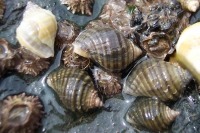
(Photo: Tracey Dean)
Dog Whelk
Nucella lapillus
Have a broad, conical shell with spiral ridges and a short, pointed spire. They usually have six swollen whorls, but the last whorl is largest. The shell is usually three centimetres tall by two centimetres wide but can be up to six centimetres tall. Usually white but is sometimes yellow, brown, or grey. They'll also sometimes have bands of alternating colours. The base of the shell opening has a short siphonal canal and the outer lip of the opening becomes thickened. The outer lip will become toothed with age.
Authority
Linnaeus, 1758
Classification Details
Phylum: Mollusca (molluscs); Class: Gastropoda (gastropod molluscs, or snails and slugs).
Habitat
Common on rocky coasts of the North Atlantic, from Long Island north to Greenland in the west, and from southern Portugal north to Iceland in the east. Can be found on sheltered shores or exposed shores, in estuaries, and in areas of low or high tidal and wave strength. Intertidal to 40 metres, from mid-shore downwards. Rare in the sublittoral, but more common in areas of extremely high tidal stress. Avoids areas of low salinity and high algal growth.
Diet
Carnivores, feeding mainly on barnacles and mussels. They may also feed on cockles, other gastropods, and assorted bivalves. They have a mouth on an extensible proboscis and a radula: a toothed appendage for rasping. One method of feeding is to shove the proboscis between the shells of bivalves and use the radula to rasp flesh. They also do this with the plates of barnacles. Another method is to use the radula and digestive enzymes to bore through shells. Once inside, it injects an anaesthetic toxin into its prey. It then secrets digestive enzymes to liquefy the flesh. They feed by sucking out the liquid.
Reproduction
Sexes are separate. They form mating aggregations of 30 or more adult individuals in early spring. Repeat cycles of internal fertilization and egg-laying take place until fall. Females lay eggs in one-centimetre, vase-shaped cases in the cracks and crevices of hard surfaces. The number of eggs per breeding season varies from 20 to 1 000. This is dependent on the individual and environmental conditions. Egg development takes about four months. The juveniles then emerge from the egg capsules as smaller versions of the adults. They reach sexual maturity at about three years and have a life span of five to six years.
Fun Facts
Body shape varies depending on shore conditions. Individuals from sheltered shores have thicker shells. This is because they need greater protection from a higher number of predatory crabs.
Individuals from more exposed shores have thinner shells, as there are fewer predators. They also have a larger shell opening for the larger foot needed to stay attached in the rough conditions.
Biocide tributyltin (TBT) an antifouling paint used on boats is threatening dog whelk populations. It has caused imposex (development of a false penis in females) and infertility. It has even caused some localized extinctions.
References
Coray C and Bard S (2007) Persistence of Tributyltin-Induced Imposex in Dogwhelks (Nucella lapillus) and Intersex in Periwinkles (Littorina littorea) in Atlantic Canada. Water Quality Research Journal of Canada 2, 111-122.
Crothers JH (1983) Variation in dog-whelk shells in relation to wave action and crab predation. Biological Journal of the Linnean Society 21, 259–281.
Crothers JH (1985) Dog-whelks: an introduction to the biology of Nucella lapillus (L.) Field Studies 6, 291–360.
MarineBio. Dogwhelks, Nucella lapillus. https://marinebio.org/species/dogwhelks/nucella–lapillus/ Accessed online 22 January 2020.
Tyler-Walters H (2007) Nucella lapillus Dog whelk. In Tyler-Walters H and Hiscock K (eds) Marine Life Information Network: Biology and Sensitivity Key Information Reviews, [on-line]. Plymouth: Marine Biological Association of the United Kingdom. Available from: https://www.marlin.ac.uk/species/detail/1501 Accessed online 22 January 2020.
Palomares MLD and Pauly D (2019) Sealife Base. Nucella lapillus (Linnaeus, 1758) Atlantic dogwinkle. https://www.sealifebase.ca/summary/Nucella-lapillus.html Accessed online 22 January 2020.


